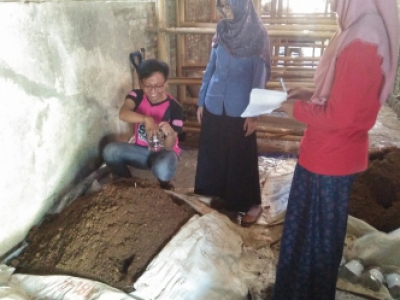UTILIZATION OF OYSTER MUSHROOMS WASTE AS FERTILIZERS

Oyster mushrooms easily grow in Indonesia because the country has a suitable climate. This type of mushrooms is very beneficial and possesses high economic value as food product. Hence, society in general are cultivating oyster mushrooms. The large number of farmers cultivating oyster mushrooms leads to abundant waste.
Such case initiated several students of Yogyakarta State University (YSU) from Faculty of Mathematics and Natural Sciences (FMNS). Under the supervision of Dr. Das Salirawati, M.Si , the students consisting of Yashinta Devi, Muhammad Yulianto Budiono, Reni Wiarti Muharomi utilized the waste as an organic fertilizer with Effective Microorganism (EM4)as concentration variation.
Devi explained, according to data from the Agriculture Department of Yogyakarta Special Province (DIY), oyster mushroom farmers are around 100 people, whose production capacity approximately reaches 13,000 bag logs per farmer. With the high number of farmers, the waste generated must be abundant, yet it is currently not well-managed. In fact, the waste has a potential to be developed into organic fertilizer.
"This research aims to find out the effect of variation in the intake of Effective Microorganism (EM4) on the quality of organic fertilizers produced from waste mushroom oysters medium, and to identify the variation of organic fertilizers from oyster mushrooms waste in accordance with the standards set out by the Ministry of Agriculture", she continued.
As part the research method, she and her team used variation in the concentration of Effective Microorganism (EM4) for producing organic fertilizer from Week 0 to Week 4 with parameters of c/n organic, water content, pH, and temperature compared with the standards.
The research began by providing the waste, then added with EM4 (concentration variations of 0%, 5%,10%, 15%,20% per 150 kg waste). Composting was done in Week 0 to Week 4. Next, they carried out tests on the moisture and nitrogen level using kjeldahl method, while testing the C Organic level was undertaken using Walkey and Black method.
Testing temperature was done by observations from the initial temperature when stirred every week at reversal process of the compost. In this study, testing the pH was done every 7 days after stirring process was complete.
From the results of research and testings, it was found that 15% EM4 is the best variation for the waste to be processed as an organic fertilizer. (witono N)

